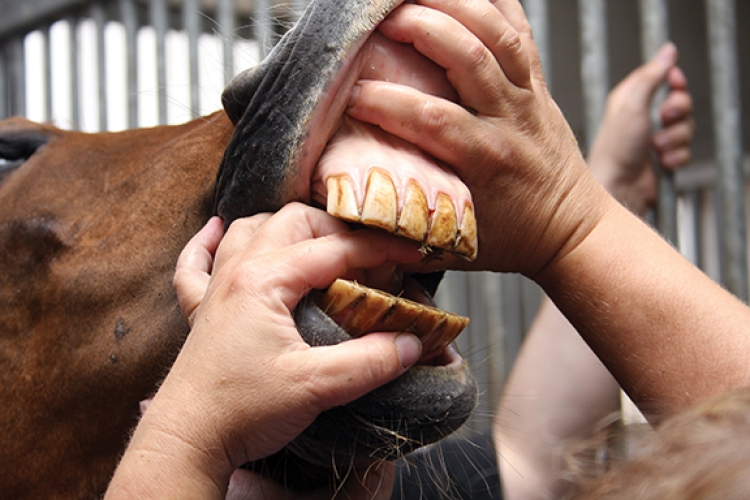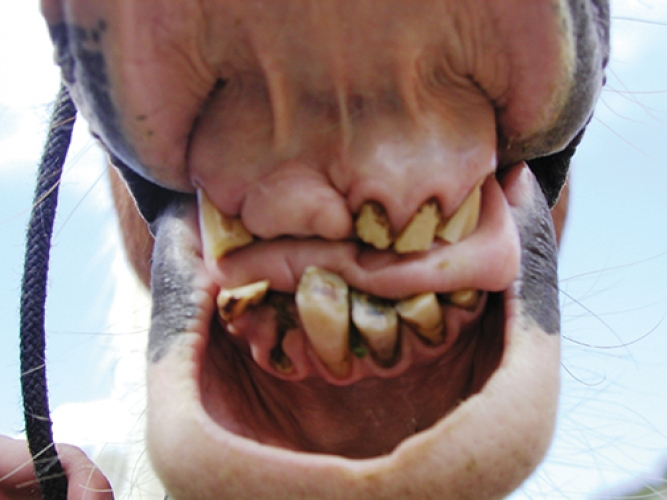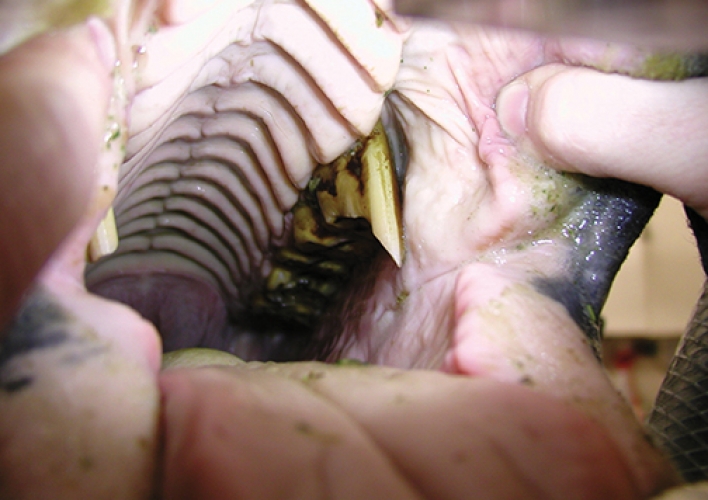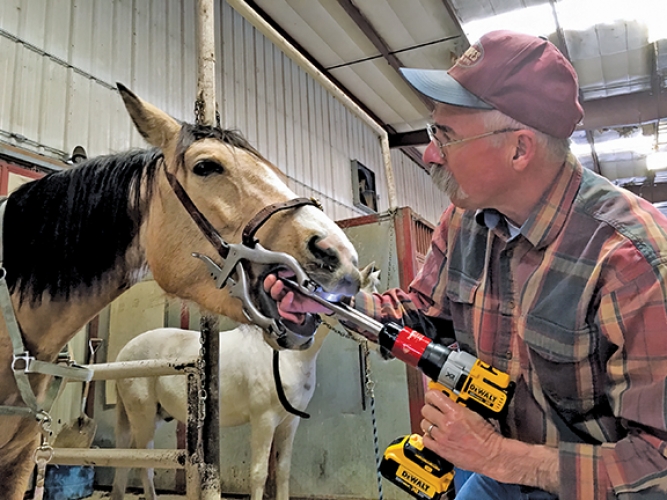
Importance Of Dental Care For Nutritional Efficiency And Performance
by Nancy S. Loving, DVM
Not only is an adequate supply of food necessary to maintain a horse’s body condition, but the teeth must be able to properly grind the feed to make full use of the diet you provide. Horses with poor teeth often need extra food to obtain sufficient calories to maintain body weight. Teeth in poor condition cause horses to take longer to chew food; if fed in a group, all food may be consumed before a slower eater has time to eat a daily requirement. Athletic horses require additional energy to sustain performance, and they especially need to make their calories count. Broodmares in the last trimester of gestation or during lactation also have intense energy demands and need to make efficient use of their feed.
Horses that fail to gain weight or experience unusual weight loss may have dental concerns at the heart of the problem. A horse with worn incisors is often less efficient in obtaining nutrients from pasture. Sharp points and edges on the molar teeth may create painful ulcers in a horse’s mouth that discourage eating even in the face of plenty. Loss of one or more grinding molar teeth prevents efficient chewing, eventually leading to development of a wave mouth – this develops from overgrowth of one or more teeth on the bearing surface opposite to a missing tooth. An irregular contact surface between the upper and lower molars compromises a horse’s ability to chew or grind feed. Grass or hay material may ball up in the side of the mouth where it lodges along the gums or is spit out as a big wad – this is called quidding. Such balls of poorly chewed food are not easily swallowed and may cause an esophageal choke.
Insufficient grinding of fiber and grains causes feed material to pass through the digestive tract without efficient extraction of nutrients. Even in the presence of adequate feed, a horse with poor dentition may develop a nutritional deficit. It is common to see coarse, fibrous material and undigested grain in the feces of a horse with poor teeth. Inadequately ground feed material also has the potential to irritate the gastrointestinal tract to elicit diarrhea; this further accelerates loss of fluids, nutrients, and electrolytes.
There are many signs that can tip you off to dental problems or inadequate grinding:
• Persistent weight loss despite availability of an adequate quantity and quality of food.
• Pain in the mouth may cause excessive salivation and drooling.
• Quidding.
• Elimination of whole grains or large pieces of roughage (greater than ¼-inch pieces) in Intermittent or chronic diarrhea due to irritation of the bowel lining by inadequately ground feed.
• Extended time to eat a meal.
• Odd head, neck, or jaw movements in an effort to relieve discomfort while eating.
• Bad breath from a rotten tooth or impacted and decaying food material.
• A unilateral nasal discharge from a sinus infection related to a diseased tooth.
• Asymmetry of the chewing muscles of the jaw due to long-term mouth disease.
• Chronic choke (esophageal obstruction).
• Chronic colic, particularly gaseous or impaction colic, due to irritation of the bowel lining or obstruction of the intestines with feed material.
• Horses with teeth problems also exhibit performance issues that range from subtle to very obvious. These include:
• Abnormal head carriage when ridden.
• Head shaking, head tossing, or tail wringing when ridden.
• Bracing against the bit when ridden.
• Refusal to stop or turn.
• Unwillingness to perform collection.
• Reluctance to perform the job intended.
Some Specific Dental Problems
Dental disease is estimated to occur in 36 – 85% of horses. Commonly found pathology includes periodontal disease, caries, wear abnormalities, and problems with eruption of teeth.
Diastema
In the normal equine mouth, cheek teeth are packed together tightly with no spaces in between. If a small pocket forms as a gap at the gum line, it forms a diastema. Most periodontal disease is associated with diastema. The periodontium supports the tooth and is made of dental cement, the periodontal ligament, alveolar bone, and the gingiva. Periodontal disease tends to be quite painful in horses, involving gingival ulceration and regression; advanced cases lead to tooth loss.
Food can fill in the gap and become impacted between cheek teeth. Acid production from bacteria and fermentation lead to inflammation, gingival ulceration, necrosis, and potential destruction of tooth cementum. Diastema are most commonly found between rear teeth of the lower jaw.
Equine Odontoclastic Tooth Resorption and Hypercementosis (EOTRH)
Equine odontoclastic tooth resorption and hypercementosis (EOTRH) occurs mostly on the incisors, sometimes the canines, and rarely on the second premolar. It tends to come on slowly, occurring mostly in horses older than 14 years of age. Initial signs show a horse in discomfort that is unwilling to bite solid food, like a carrot or eating from a hay net. Commonly, tartar accumulates on the teeth, around the gums, and exposed tooth roots. Most telling is that the gums are inflamed and rather than a normal smooth appearance, they are ridged with lumps over the roots, often affected by small gum abscesses.
The hypercementotic form involves gradual disappearance of the space around a tooth as root tissues are progressively replaced with alveolar bone. Another form involves disintegration of the tooth roots, resulting in loss of dental tissue and adjacent alveolar bone.
Radiographic evaluation is helpful in diagnosis. The earlier the diagnosis, the better chance of mitigating inflammation and slowing progression of EOTRH.
Dealing with Bit Seats and Wolf Teeth
Bit seats are no longer considered a necessary procedure in equine dentistry. A bit should never fit against the teeth in the first place so if a horse resists the bridle or tosses its head, it is best to look for a different problem.
Similarly, wolf teeth only need to be removed if they are causing an obvious problem. For a horse that is performing well, there is no reason to remove them.
Odontoplasty (Floating)
It helps a horse to chew efficiently by filing down sharp points on molar teeth in a process called floating or odontoplasty. Abnormally long teeth or incisors can also be ground off with special instruments to eliminate pain associated with chewing. Tooth comfort helps to improve digestive efficiency and allows a horse more comfort in the work he is asked to do.
It is critical that any dental work done with power equipment includes water cooling systems to avoid overheating teeth and deeper dental tissues. Studies have demonstrated significant adverse effects from overheating and thermal damage of dental tissues. Increase in tooth pulp temperature by 3.3o C leads to potentially irreversible changes while an increase greater than 5o C leads to pulpitis or pulpar necrosis in 15 % of teeth. Even 30 seconds of grinding without water cooling can increase the thermal insult to 5.5o C in 20% of teeth, which results in an irreversible pulpal necrosis rate of 3 %. All teeth will undergo pulpar necrosis with an increase of heat of more than 16.1 o C.
It is worth noting that 30 seconds of odontoplasty removing 5 mm of dental tissue results in excess pulpal heat 20 % of the time. Thermal damage results in pain and potential death of a tooth, resulting in the potential need for extraction or rare instances of root canal. Water cooling reduces the risk of thermal injury by seven-fold, and no more than 3-4 mm of teeth should be removed at any one time.
The Bottom Line
Regular dental care is an important part of successful management of horses of all ages. Schedule visits with your veterinary dentist at least twice a year. A thorough dental exam by your veterinarian additionally helps to determine if the diet fed is appropriate for the dentition and performance needs of that individual.





